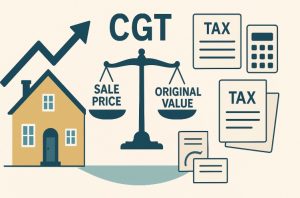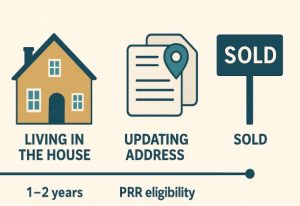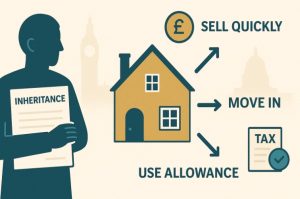Capital Gains Tax (CGT) is a significant consideration for homeowners and property investors in the UK. Whether you’re planning to sell your home or dispose of a second property, understanding how to legally avoid CGT can save thousands of pounds.
One of the most common questions asked is: how long do you have to live in a property to avoid Capital Gains Tax in the UK?
This article provides a comprehensive guide to CGT rules, exemptions, and strategies you can use to reduce or completely eliminate your CGT liability when selling a property.
What Is Capital Gains Tax And When Does It Apply To UK Property?

Capital Gains Tax (CGT) is a tax applied to the profit made when you sell or dispose of an asset that has increased in value.
For residential properties, CGT is only due when the property is not your main home. This usually includes:
- Second homes
- Buy-to-let properties
- Inherited properties that are sold later
- Homes not used as your main residence during the period of ownership
The tax is applied to the gain, not the full sale price. If you bought a property for £250,000 and sold it for £300,000, CGT would apply to the £50,000 gain, subject to allowances and exemptions.
How Does Private Residence Relief Help You Avoid CGT?
Private Residence Relief (PRR) is the primary method for avoiding CGT when selling your home. If the property has been your main or only home throughout your ownership, you may not owe any CGT at all.
You must genuinely live in the property and show it was your primary residence. This is typically supported by:
- Utility bills and council tax addressed to you
- Registration on the electoral roll
- Correspondence from banks or HMRC
- Change of address on your driving licence or with your GP
Under PRR rules, even if the entire period of ownership was not spent living in the property, the final nine months are always CGT-exempt.
Certain absences also qualify for PRR, such as:
- Up to four years working away from home (in the UK or abroad)
- Unlimited time if you were posted overseas by your employer
- Time spent in care homes or hospitals in certain cases
How Long Must You Live In A Property To Qualify For CGT Exemption?

There is no legally defined time frame to qualify for Private Residence Relief. However, HMRC focuses on the quality and not just the duration of residence.
A period of one to two years of continuous residence provides strong grounds for claiming PRR. If you lived in the property for less than that, you must demonstrate that your intention was to make it your main home.
Key factors that determine qualification include:
- Time spent living at the property
- Where your post is delivered
- Whether you registered at the address for council tax and utilities
- Where your children attend school
- If your bank and government records show the property as your main address
PRR Qualification Based On Residency Duration
| Duration of Residence | PRR Likely to Apply | Additional Conditions |
| 3+ years | Yes | Minimal evidence required |
| 1–2 years | Possibly | Strong supporting documents needed |
| Less than 1 year | Unlikely | Must show clear intent and usage |
Short-term residence can still qualify if backed by robust evidence, but deliberate short occupancy to avoid CGT is likely to be challenged by HMRC.
What Are The CGT Rates For Property Sales In 2024/25?
For the 2024/25 tax year, the CGT rates applicable to residential property in the UK are:
- 18% for basic-rate taxpayers
- 24% for higher-rate and additional-rate taxpayers
The rate you pay depends on the amount of gain and your total taxable income in the year of the sale. The gain is added to your income and the applicable rate is determined accordingly.
Each individual also has a CGT tax-free allowance of £3,000 in the 2024/25 tax year.
CGT Calculation Examples
| Taxpayer Type | Gain on Sale | CGT Rate | CGT Payable |
| Basic-rate taxpayer | £20,000 | 18% | £3,600 |
| Higher-rate taxpayer | £20,000 | 24% | £4,800 |
| Couple (basic-rate) | £40,000 | 18% | £7,200 |
Taxpayers can deduct certain costs from their gain to reduce the taxable amount. These include:
- Solicitor and estate agent fees
- Stamp duty and legal fees during purchase
- Home improvement costs that added value
When Must You Pay Capital Gains Tax On UK Property?
When you sell a UK residential property and a CGT liability arises, you must report and pay it within a specific timeframe. Since 6 April 2020, the rule requires individuals to:
- Report the gain to HMRC within 60 days of the sale completion
- Pay any CGT owed within the same 60-day period
This is done through HMRC’s online CGT on UK Property service.
Failure to meet the 60-day deadline may result in:
- Late filing penalties
- Interest charges on unpaid tax
It is recommended to have all financial records and property documentation prepared in advance to avoid delays or mistakes in reporting.
How Can You Avoid Capital Gains Tax On Inherited Property?

When a property is inherited in the UK, there is no Capital Gains Tax (CGT) liability at the time of inheritance.
Instead, CGT becomes relevant only when the inherited property is sold. The taxable gain is calculated based on the difference between the market value of the property at the date of inheritance and the sale price.
For example, if a property was valued at £250,000 when inherited and later sold for £300,000, CGT may be due on the £50,000 gain, after deducting allowable costs and tax-free allowances.
Legal Strategies to Minimise or Avoid CGT on Inherited Property
There are several legal and effective ways to reduce or completely avoid CGT on inherited properties:
1. Make the Inherited Property Your Main Residence
One of the most effective methods to avoid CGT is to move into the inherited property and designate it as your main home. Doing so may allow you to claim Private Residence Relief (PRR), either in full or partially.
To qualify:
- You must genuinely live in the property as your main residence
- You should update your address on official records such as council tax, bank, and HMRC
- The property should be your primary home for a reasonable duration
- PRR will exempt the gain attributable to the period of occupation, as well as the final 9 months before sale
This strategy is particularly useful when the property has appreciated significantly in value since the time of inheritance.
2. Sell the Property Soon After Inheriting It
Selling the inherited property shortly after taking ownership may result in minimal or no CGT, particularly if the property’s value has not increased much since the date of inheritance.
In such cases, any gain may fall within your annual CGT allowance, making the transaction tax-free.
This is most effective when:
- The market is relatively stable
- The inherited property was not rented out or significantly improved
- The sale occurs within months rather than years of inheritance
3. Use Your Annual CGT Allowance
Every individual in the UK is entitled to a tax-free CGT allowance, which is £3,000 for the 2024/25 tax year. Couples who jointly inherit and sell a property can combine their allowances to gain £6,000 of tax-free capital gains.
Ensure that:
- You and your spouse/civil partner are both named on the property title
- The sale proceeds are split accordingly to reflect shared ownership
4. Offset Capital Losses Against Gains
If you have other investments or properties that have been sold at a loss, those capital losses can be offset against the gain made from the inherited property. This can significantly reduce or even eliminate CGT liability.
Losses must be:
- Realised in the same tax year, or carried forward from previous years
- Reported to HMRC within four years of the end of the tax year in which the loss occurred
5. Transfer to a Spouse or Civil Partner Before Sale
Transferring part or all of the inherited property to your spouse or civil partner before sale allows you to double the available CGT allowance. Spousal transfers are CGT-free, making this a tax-efficient method for planning a future sale.
This method allows:
- Shared use of allowances and tax bands
- Strategic planning to lower total CGT by using both parties’ basic-rate tax bands, if applicable
6. Claim Allowable Costs
When calculating the gain on an inherited property, you can deduct certain costs from the sale proceeds, including:
- Legal and probate fees
- Estate agent and solicitor fees at the time of sale
- Improvement costs (e.g., renovations, extensions) that have increased the property’s value
These deductions help reduce the taxable gain and therefore the final CGT liability.
What Are The Most Effective Ways To Reduce Or Avoid CGT On Property?

Reducing or avoiding Capital Gains Tax (CGT) on property in the UK requires a combination of strategic planning, timely actions, and understanding the reliefs and exemptions available under HMRC rules.
While full exemption may not always be possible, there are several effective and legal ways to significantly reduce the amount of CGT you may owe when selling a property.
Below are the most commonly used strategies to minimise CGT liability on UK property sales:
1. Use Your Annual CGT Allowance
Each individual in the UK is entitled to a CGT-free allowance, known as the Annual Exempt Amount. For the tax year 2024/25, this allowance is:
- £3,000 per individual
- £6,000 per couple (if the property is jointly owned)
By ensuring your gain falls within this threshold, you can avoid paying CGT altogether. If your gain exceeds the allowance, only the excess amount will be taxed.
2. Offset Capital Losses Against Gains
Capital losses from other assets, such as shares or investment properties, can be used to offset capital gains from the sale of a property. These losses can:
- Be used in the same tax year as the gain
- Be carried forward to future tax years if not used immediately
- Reduce the taxable gain, potentially bringing it below the CGT allowance
For example, if you made a £10,000 gain on a property and incurred a £7,000 capital loss from a stock investment in the same tax year, you would only be taxed on the £3,000 net gain.
3. Transfer Property to Your Spouse or Civil Partner
Transferring part or all of the property to your spouse or civil partner before the sale can be a highly effective way to reduce CGT. Transfers between spouses and civil partners are free of CGT, allowing you to:
- Utilise two CGT allowances
- Split the gain to keep both parties in the lower income tax band
- Strategically plan the sale to reduce the overall tax burden
This method is especially useful when one spouse has unused CGT allowance or falls into a lower tax band.
4. Reduce Your Taxable Income
CGT rates for residential property depend on your income tax band. If your total income and gains push you into a higher tax bracket, you will pay 24% CGT instead of 18%. Reducing your taxable income can help ensure that more of your gain is taxed at the lower rate.
You can reduce taxable income by:
- Making pension contributions
- Delaying other sources of income
- Using salary sacrifice schemes
- Deferring bonuses or dividends to the following tax year
5. Contribute to a Pension
Pension contributions lower your total taxable income, which can have a direct impact on your CGT rate. For example:
- A pension contribution might bring your income below the higher-rate threshold
- As a result, more of your capital gain would be taxed at 18% rather than 24%
This method is both tax-efficient and beneficial for long-term retirement planning.
6. Make Charitable Donations
Donating to registered UK charities allows you to claim tax relief, which in turn reduces your total taxable income. By reducing your income, you may:
- Lower the portion of gains subject to higher CGT rates
- Stay within the basic rate tax band
This is a useful strategy if you’re close to the higher-rate income threshold.
7. Sell The Property In Phases Across Tax Years
If you can structure the sale of your property over two tax years (e.g. selling multiple units in a block or selling shares of the property), you can:
- Make use of two CGT allowances (one in each year)
- Manage the amount of gain taxed in any one tax year
- Potentially stay within the basic-rate income band
This approach requires careful planning and may only be feasible for certain types of properties or investments.
8. Reinvest Gains Into CGT-Exempt Investments
Some investments offer relief or exemption from CGT, such as:
- Enterprise Investment Scheme (EIS)
- Seed Enterprise Investment Scheme (SEIS)
- Social Investment Tax Relief (SITR)
By reinvesting gains from a property sale into qualifying schemes, you may:
- Defer CGT until you dispose of the new investment
- Claim partial or full exemption from CGT on those gains
- Support UK small businesses and start-ups while gaining tax advantages
These investments carry a higher risk but can be very attractive for experienced investors.
9. Claim Costs Of Property Improvements
When calculating the capital gain, HMRC allows you to deduct the cost of capital improvements made to the property during your ownership. These improvements must:
- Add value to the property (e.g. extensions, loft conversions)
- Not be classed as maintenance or repair (e.g. painting, replacing windows)
Valid costs may include:
- Architect fees
- Building materials and labour
- Planning application fees
- Structural changes
Keeping thorough records of all expenses will help reduce your taxable gain and ensure compliance with HMRC rules.
10. Claim Letting Relief (If Applicable)
Letting Relief used to provide additional CGT exemption for landlords, but the rules changed significantly in April 2020. Currently, Letting Relief only applies if:
- You lived in the property at the same time it was being let
- It was your main home during the letting period
In such cases, Letting Relief may still reduce the CGT owed, although the available relief is now more limited than in the past.
Can You Avoid CGT By Living In A Buy-To-Let Or Second Home?
Yes, but the relief is only partial. If you move into a rental or second property and make it your main home:
- You may qualify for PRR for the duration of occupancy
- The final nine months of ownership will be exempt regardless of whether you lived there during that time
The rest of the ownership period, during which the property was not your main residence, may still be subject to CGT.
Letting Relief, which used to offer an additional CGT reduction for rental properties, has been restricted since April 2020. It now only applies if the owner lived in the property at the same time as the tenant.
How Does HMRC Determine Your Main Residence?

HMRC assesses your main residence based on factual evidence rather than just the address on file. Factors considered include:
- How long you lived at the property
- Where your personal possessions are kept
- Which property you spend the most time at
- Address used on tax returns, bank statements, and utility bills
- Electoral register and council tax registration
A combination of these indicators is used. No single piece of evidence is definitive, so the stronger and more consistent the documentation, the better your claim for Private Residence Relief.
Conclusion
In conclusion, avoiding Capital Gains Tax on UK property largely depends on whether the property qualifies as your main residence under HMRC’s rules.
By living in the home for a genuine period and maintaining accurate records, you may benefit from full or partial Private Residence Relief.
Understanding tax rates, allowances, and strategic planning can further reduce liabilities. For inherited or second properties, applying legal exemptions and timing the sale wisely can make a significant difference in your overall tax obligation.
FAQs About CGT and UK Property
How do I nominate my main residence to HMRC?
You can notify HMRC of your nominated main residence in writing within two years of acquiring a second property. This helps protect your PRR claim.
Is there CGT if I sell my home after living in it for 6 months?
Possibly, yes. Six months might not be enough unless you can provide strong evidence that it was your genuine main home.
Can I avoid CGT if I gift property to my children?
Gifting to children is a disposal for CGT purposes and may incur tax if gains exceed your allowance. Gifts to spouses are CGT-exempt.
What happens if I move into my buy-to-let before selling?
You may qualify for PRR for the period you live there, plus the final 9 months. The rest of the gain may still be taxable.
Do I pay CGT on a jointly owned property?
Yes, each owner may have a CGT liability based on their share of the gain, but both can use individual CGT allowances.
Does CGT apply to overseas properties?
Yes. UK residents must pay CGT on worldwide property gains. The same rules apply regarding PRR and allowances.
What documents should I keep to reduce CGT?
Keep records of purchase price, legal and improvement costs, valuations, utility bills, and any evidence of occupancy to support your claim.






